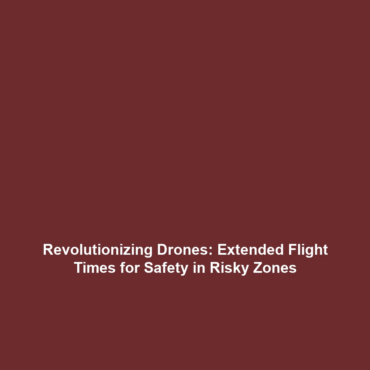Advancements in Drone Technology Allowing Extended Flight Times in Dangerous Areas
Drones are transforming the landscape of scientific research, enabling unprecedented access to dangerous or inaccessible environments. Recent advancements in drone technology, particularly in battery life and energy efficiency, have allowed for extended flight times in hazardous conditions. These developments are vital for scientific applications, ranging from disaster response to environmental monitoring, as they enhance our ability to gather critical data safely and efficiently.
Key Concepts
Understanding the major concepts surrounding advancements in drone technology is fundamental to grasping their impact on drones in science.
Battery Technology Improvements
Advancements in lithium polymer battery technology have significantly increased the flight times of drones. New materials and energy-efficient designs allow drones to operate longer without the need for recharge, making them ideal for extended missions in dangerous areas.
Solar Power Integration
Incorporating solar cells into drone designs is a revolutionary step that allows drones to harness solar energy, further extending flight durations. This technology is especially beneficial for scientific explorations in remote locations where charging infrastructure is lacking.
Applications and Real-World Uses
The applications of advancements in drone technology allowing extended flight times in drones in science are numerous and impactful:
- Disaster Response: Drones can survey disaster zones for damage assessment, search and rescue operations, and deliver supplies to affected areas.
- Environmental Monitoring: Long-duration drones are capable of collecting data on wildlife, vegetation health, and pollution levels over extensive areas.
- Archaeological Research: Archaeologists use drones to map and survey sites that are otherwise difficult to access on foot.
Current Challenges
While significant advancements have been made, there are still several challenges of extending drone flight times that must be addressed:
- Limited payload capacity may restrict the types of sensors and equipment that can be used.
- Environmental factors such as wind, snow, and rain can significantly affect drone performance.
- Regulatory hurdles may limit where and how drones can be deployed during extended missions.
Future Research and Innovations
Looking ahead, several innovations are on the horizon that will continue to revolutionize advancements in drone technology allowing extended flight times:
- Hybrid Energy Sources: The development of drones that utilize both fuel and electric power could solve many issues related to energy efficiency and flight duration.
- Autonomous Navigation Systems: Enhanced AI and machine learning algorithms will improve route planning and allow for more complex missions with minimal human intervention.
- Swarm Technology: Future advancements may enable multiple drones to work together autonomously, significantly increasing data collection capabilities in challenging environments.
Conclusion
In summary, advancements in drone technology allowing extended flight times in dangerous areas represent a significant breakthrough in the field of drones in science. By enhancing our ability to conduct research and gather data in hazardous environments, these technologies are poised to have a lasting impact on scientific inquiry and disaster response. To learn more about related topics and explore ongoing advancements, visit our other articles on drone technology and scientific applications.
